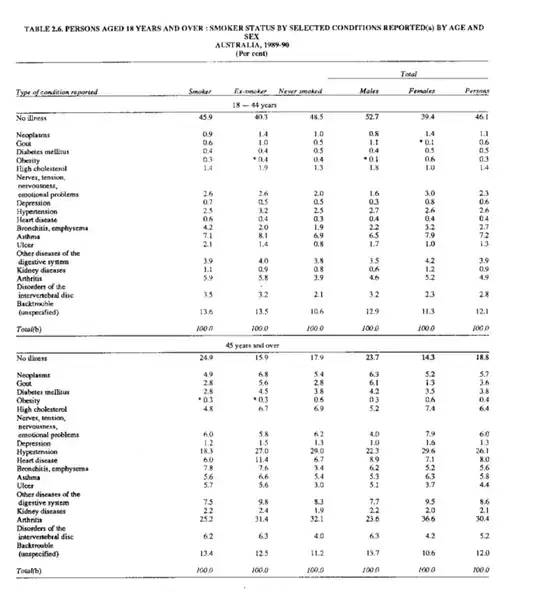Yes, smokers probably function with less oxygen, but is this really a bad thing?
My comments are strictly for the open minded!
I am a 50 year old chronic cigarette smoker and my readings are usually in the range of 97 - 100 when my hands are warm. I have had readings of 100+ on a few occasions which I assume to be a fault of the machine!
I think it is highly plausible that smokers have less oxygen running around the blood stream and as JohnP points out CO has very pointy elbows
in a queue to get on the bus! But where I differ is that this is not neccessarily a bad thing! It could actually be theraputic for certain conditions where a there is less oxygen in the blood stream than is desirable. Take for example emphysema.
In this study from the Australian Bureau of Statistics, where the study subjects were picked at random from the general population and asked to self report on their health and smoking status.It showed that never smokers have a higher percentage of pretty much all diseases (including cancers and hypertension etc) with the exception of bronchitis and emphysema which is consistent with a causal hypothesis for smoking.
For persons over the age of 45 the percentages are for bronchitis and emphysema:
- smokers 7.8%
- former smokers 7.6%
- never smokers 3.4%
So smokers have double the risk for bronchitis and emphysema compared to never smokers and although this risk is not as great as many figures that the anti-smoking industry alludes to , it is however a significantly larger risk. And as this study is randomised it is likely to be a fair
reflection of reality.
See above figures in table below.

Both smokers and former smokers have roughly double the rate of bronchitis and emphysema which is consistent with the hypothosis that
smoking caused these conditions through some unknown mechanism. But it could also be that smokers are choosing to smoke because they feel an immediate therapeutic effect from smoking. And stopping smoking did not significantly reduce the number of former smokers that got the disease (7.8% vs 7.6%) which suggests that smoking may not be causal and could be merely therapeutic.
Paracetamol has an immediate therapeutic effect for people but we don't just assume that it causes every disease known to human kind just because
people that use it have diseases. We know that it is an analgesic and people use it for pain relief. If tobacco were paracetamol, the anti-smoking industry could plausibly claim that it causes all known diseases but without supporting evidence it would be foolish to believe it.
If it is true that healthy smokers go about their day to day business with significantly less oxygen than their never smoking friends then this is another way of saying smokers can function with less oxygen. It is as if smokers are just permanently altitude training. When never smokers do their daily business at sea level smokers are doing the same but a few thousand feet further up. This is all quite rational I think.
But is there evidence that smoking has an immediate therapeutic effect for oxygen starved people?
I can find anecdotal evidence from mountain climbers here is a quote from a Mount Everest expedition in 1922. Source the Guardian
Cigarettes as an aid to climbing Report, November 21 1922
Captain GJ Finch, who took part in the Mount Everest expedition, speaking at a meeting of the Royal Geographical Society, London, last evening on the equipment for high climbing, testified to the comfort of cigarette smoking at very high altitude. He said that he and two other members of the expedition camped at 25,000ft for over 26 hours and all that time they used no oxygen.
About half an hour after arrival he noticed in a very marked fashion that unless he kept his mind on the question of breathing, making it a voluntary process instead of an involuntary one, he suffered from lack of air. He had 30 cigarettes with him, and as a measure of desperation he lit one. After deeply inhaling the smoke he and his companions found they could take their mind off the question of breathing altogether ... The effect of a cigarette lasted at least three hours, and when the supply of cigarettes was exhausted they had recourse to oxygen, which enabled them to have their first sleep at this great altitude.
Take this study of coal miners https://www.ncbi.nlm.nih.gov/pubmed/2523477 it could be that smoking contributed towards their condition but it is also equally rational that many smokers just felt an immediate therapeutic effect as our mountaineering friends said.
The important point here is not whether smoking helped them, our mountaineering friends, to cope with less oxygen, although it may well have done as they clearly thought it did, the point is that they felt it did, hence possibly explaining the roughly double risk for bronchitis and emphysema for smokers in the above study.
